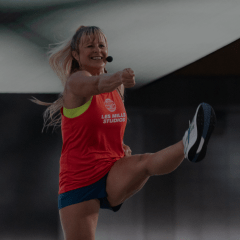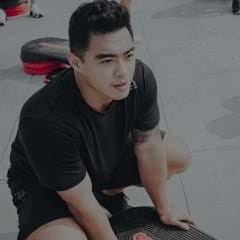How do I motivate?
I guess I do have a particular style and it’s definitely intrinsic motivation. I’ve never been about the aesthetic, ever. I’m always about the feeling of exercise because that’s authentic to me and I also think that caters to a larger number of people: feeling good because you chose movement today.
It's just who I am as a person. I always want to make sure that I'm giving people value, that I'm not wasting their time. I genuinely have this deep belief in people – both in fitness and life. If my husband has a passion, I just so badly want him to be successful and be happy. If my friend has something that they want to achieve but they’re not sure they can do it, I always want to help them believe in their own talent. People have so much potential and I think that they just don't see it. But I see it. It's like I have special glasses.
So, when it comes to motivation, I want people to know that I believe in them, and I want to give them the tools to achieve their goals in class.
Motivation is different for everybody. Your quality of movement could be the thing that's motivating about you. Maybe you're an incredible dancer or are perfect in your BODYPUMP technique. It doesn't always have to be verbal.
The first part of creating motivation is to have a real connection to and understanding of the program that you’re teaching.
You need to be connected to the essence of the program. The way I motivate in LES MILLS TONE™ or BODYPUMP™ is completely different to the way I motivate in LES MILLS SPRINT™ or THE TRIP™.
If we look at a strength-based program like BODYPUMP, the essence is to be strong and grounded. I guess there’s a typical person who comes to BODYPUMP who wants to get typical results: get stronger and improve their technique. But when it comes to TONE, the essence of that program is around fun and athleticism. It’s more about working the stabilizing muscles, so I’ll try to think of motivation that supports that focus.
You’ll never see SPRINT Khiran in TONE. They are completely opposite programs. With SPRINT, it’s pure HIIT training. It’s hard and it’s horrible but if you do it right, you will get the results. The fact that all Les Mills programs are backed by science gives me the confidence to go in and tell people that if they do the thing, they will achieve their goals. We haven’t just put a random mix of moves together and hoped for the best or that one percent of people will get it – these programs have been tested and the results are guaranteed.
And then in BODYBALANCE™, I have a completely different motivational style again. When I teach that program, I’m very spiritual – which you would never guess from seeing me teach SPRINT. But it’s very authentic to me. If you came to my house you would see I have a crystals EVERYWHERE!
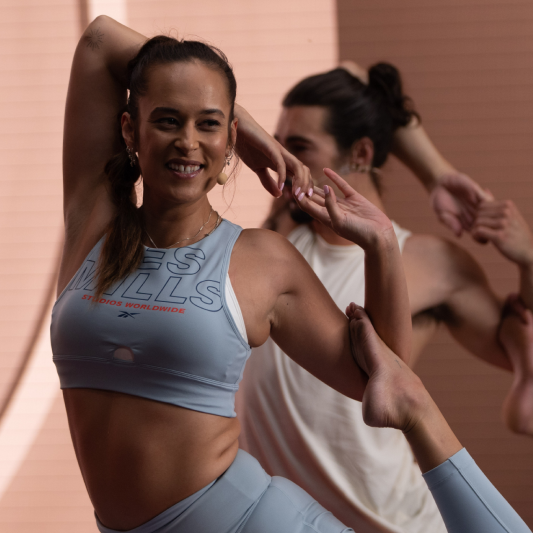
Once I’ve connected to the program, I like to set an outcome. This might be for the track itself, or for the entire class. I have a group of people in front of me, and they want to achieve something particular from their training, whether it be to feel good, get a little stronger, or improve their health. I try to base my motivation around that so I’m not off on a random tangent saying something irrelevant.
I never script the exact words I’m going to use.
I’ll think of something like a technique or an idea I want to bring in, but the words themselves are always in the moment. In my mind, it’ll be: "insert motivation here". Actually, I often forget what I say on Masterclass because it's so in the moment. The biggest thing is to associate a feeling with the movement rather than thinking about the task itself. For example, when I said: “your legs carry you your whole life, let’s give them some love” in the Squat track in BODYPUMP 118, that was inspired by a conversation I saw on social media about pump weight selection. It was around not lifting enough in squats and I thought to myself: hold on, our legs literally carry our entire body all day everyday, any extra weight they carry should be celebrated.
Or in BODYPUMP 122, in the Back Track, when I said, “this is your kind of training, with your kind of people” – that came from filming week. Glen sat all of us down as a team and told each of us what he loved about our coaching, what our unique strengths were. It was powerful to hear that from him, and the cue came from my feeling inspired by the power of our team.
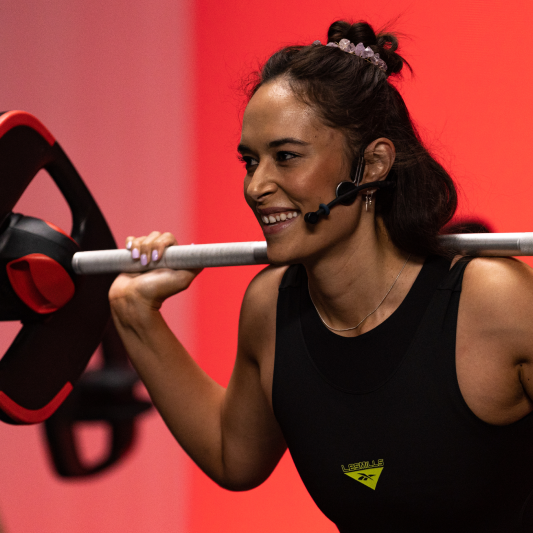
Some Instructors don't refresh their motivation.
I hear them saying the same cues and they’ll use them across every program that they teach. And that's not a bad thing. But it's also not genuine. Motivation has to come from a place of real care and belief in the people that are in front of you. It's like how you deliver the praise, “good job”. You can say, “good job” in a very throwaway manner and people will be like, okay, well, she was full of crap. Or if you're really genuine about it, it's like “that was a good job”, and say it like you mean it. I feel like that's the same with motivation as well.
In terms of updating my motivation, I listen to a lot of podcasts and I read a lot about different techniques and ways to achieve goals. My bible books are "Atomic Habits", by James Clear and "Relentless" by Tim S Grover. I also love Agile Coach podcasts because they're all about mindset. They're about experimentation and inspection and adoption.
Use the first track to gauge your audience because if you come in all hot and firing about human growth hormone and how the training is going to make you such an athlete but you have a bunch of moms in the room – it might not land.
I'm constantly questioning if what I'm saying is valuable
At the end of the day, people are giving up their time to be here. I want to make sure that what I'm saying adds value to their journey. You can only go and see your favorite movie so many times before you know the lines that are coming and they no longer have the same impact they did the first time, right?
It’s the same with motivation. If you say the same thing every single class, it starts to lose its impact. There’s one class I attend and in the recoveries, the Instructor always tells me to “breathe”. And yes, I understand the intention behind it, but they literally say it in every recovery. In my head, I’m thinking: “I am breathing. It makes me want to stop breathing so you have to resuscitate me and use your CPR skills”. Obviously, I’m being facetious but I’m sure you get my point!
To find the perfect recipe for motivation, first off you have to trust the fact that people are coming to your class for you – there's something about your style resonates with them. Be confident in that. And then think about the program and what outcome you want for the class.
What are you known for?
Motivation is different for everybody. Your quality of movement could be the thing that's motivating about you. Maybe you're an incredible dancer or are perfect in your BODYPUMP technique. It doesn't always have to be verbal. A lot of the motivation that comes from my husband, Vili, is that he’s a pure athlete and when he teaches BODYPUMP, his movement is inspirational. He makes the barbell float.
Or with Glen Ostergaard, he’ll never do a big motivational spiel in SPRINT like I do, but the just the way he moves on the bike is motivating. When Glen and I teach together, we’re like yin and yang. My strength sits in the coaching space, and his is in the way he moves. He’s incredible, and I’m motivated just by watching him on the bike. It’s impressive and it’s inspiring.
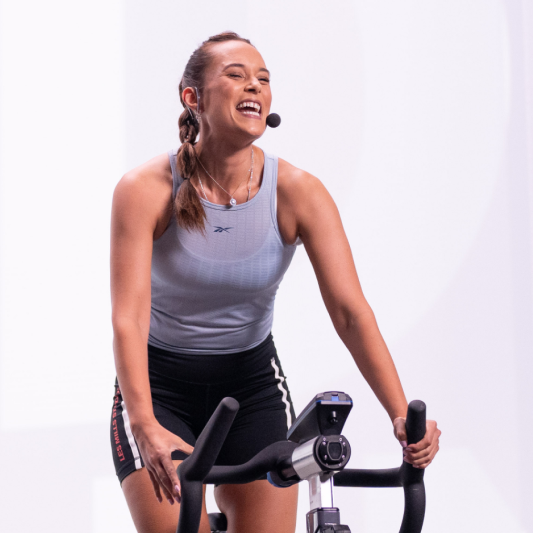
My five tips for your next class are:
- Identify what you’re excited about, whether that be the playlist or the type of training. If you’re walking in feeling down on the fact that you don’t love BODYPUMP 122, for example, you’re already starting on the back foot. It has to started with enjoyment; you need to be pumped.
- Have an outcome for your class. Whether that’s: "today I want to make sure that everyone understands the purpose of doing a million and one pulses" or whatever the thing is.
- Use the first track to gauge your audience because if you come in all hot and firing about human growth hormone and how the training is going to make you such an athlete but you have a bunch of moms in the room – it might not land. You might have intentions to talk about how we’re firing up the neuromuscular system but if this isn’t going to be right for your audience – prepare to pivot.
- Know your music so you know where you’re going to drop in your motivation. So if you’ve got 72 pulses in a row, you’re probably not going to drop your motivational cues in the first 20. You’re going to save it for that halfway point to keep people going – bring them home sort of thing.
- Finally, don’t use cues from the Masterclass if they don’t resonate with you! Be authentic to who you are and where you live. I’m pretty sure in middle America you don’t say: “shot, bro”. Use the Masterclass as an example and then change up the words and language so it’s appropriate for you and your audience.
I also encourage you to think about the program from a participant's perspective. Sometimes we can be in teacher mode constantly and forget what it's like to be a beginner or a regular participant. Different people are going through different stages in their fitness journey and they've been with the program for different lengths of time. Sometimes we can be so fixated on “I have to learn the choreography and then I have to hit these coaching layers” that we forget about like we're actually teaching fitness. And not only that – we're providing people with a fitness experience. At the end of the day, it's the experience will get them coming back not only to that program, but to you as an Instructor.
Khiran Huston (New Zealand) is a creative for LES MILLS TONE and a Trainer/ Presenter for LES MILLS TONE, LES MILLS SPRINT, LES MILLS THE TRIP, LES MILLS GRIT, BODYPUMP, and RPM. She works as Group Fitness Project Manager at Les Mills International in Auckland and is a Les Mills Ambassador for BODYBALANCE, LES MILLS TONE, LES MILLS SPRINT, LES MILLS THE TRIP and BODYPUMP.




